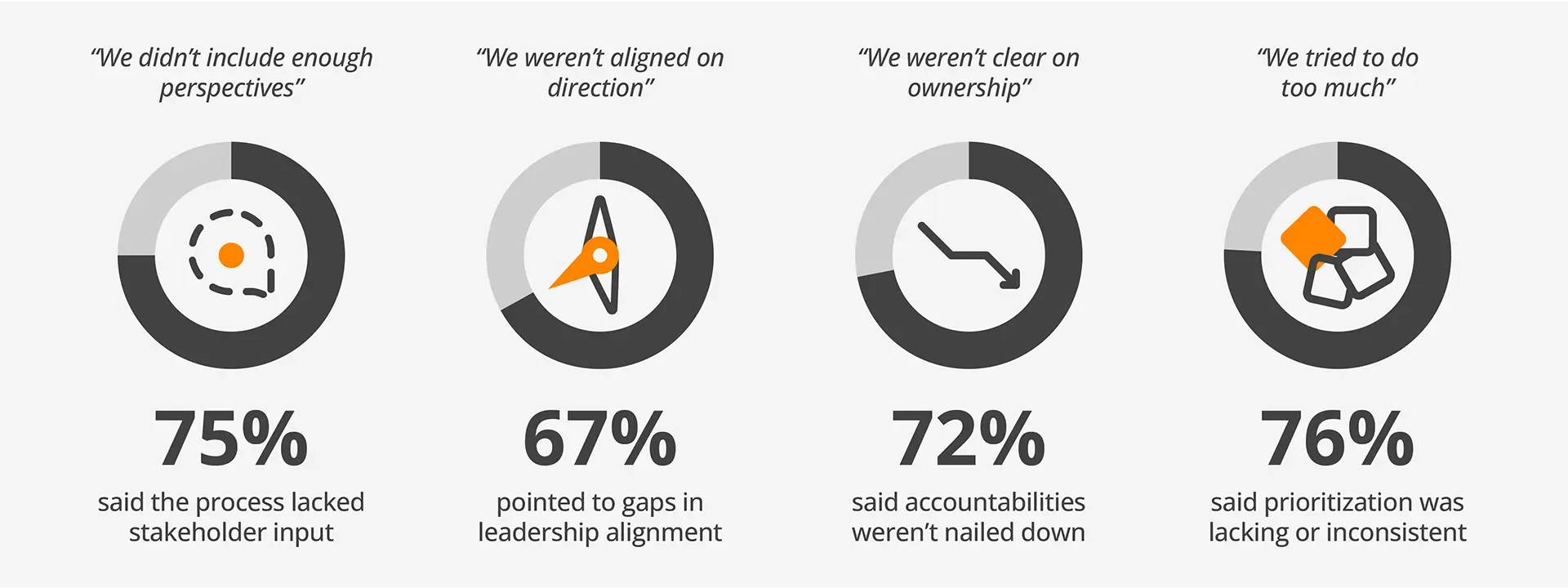
Article
Why Do So Many Strategies Fail, and What You Can Actually Do About It
Jordan Shapiro, Peter Bowman — July 31, 2025
You’ve seen it before. The ambition is bold. Leadership aligns (at least in theory). The plan is handed down and the teams get to work… but over time the results fall short. This isn’t uncommon. Level5 research shows over 80% of strategies fail to deliver on their intended goals.
So where does it break down and why do so many strategies fail?
So where does it break down and why do so many strategies fail?
When we asked senior leaders what got in the way, we didn’t typically hear “bad strategy” or “poor ideas.” We heard things like:

None of these are failures of ambition. They’re failures in how the plan was designed and delivered.
Here’s the good news: these issues are predictable. Which means they’re fixable – more effective planning up front and adaptive execution practices that bring people together across functions, not just within them, can make your strategy stick.
1. Plan in a way people can actually deliver
Too often strategy processes are ‘locked-room’ exercises. A small team builds the plan, then pushes it out to
the organization with the assumption that the rest will follow.
In reality, people struggle to connect their day-to-day work with the plan — or worse, they don’t see the plan
as relevant for themselves.
You’ve probably heard some of these symptoms:
- “We have too many priorities.”
- “I’m not sure who’s actually responsible for this.”
- “We didn’t have input into this.”
- “We’re running hard, but I’m not sure we’re running in the right direction.”
These problems start early, in how the plan is built.
Better planning starts with asking the right questions:
- Are we building our plan on facts and input, or on assumptions and politics?
- Are we aligned on a short list of shared enterprise priorities?
- Do people know who is accountable for what?
- Are we clear on what success looks like, and how we’ll measure it across functions?
Approach in Action
At one client, a Cold Storage and 3PL provider experiencing rapid expansion, leadership recognized that their traditional, ad hoc approach to managing operations couldn’t scale with the pace of their growth. Historically, a small group of individuals had made most of the decisions, but as the organization evolved, they needed a more structured, shared approach to strategy.
We partnered with a cross-functional group of leaders to define a focused set of ambitions grounded in their collective insight. Together, we translated those priorities into a clear, actionable roadmap – outlining specific steps, ownership, and success measures that the entire organization could understand and deliver. By involving the people responsible for execution early in the planning process, the strategy felt relevant, owned, and real – not just a slide deck from the top.
What better looks like:
A strategy that’s shaped by the people who’ll deliver it. Where functions aren’t just consulted, they are owners of the process and output. Where objectives are shared, not siloed. And where accountability is documented early, not sorted out mid-flight.
How to get there:
- Align on a clear ambition and 3–5 enterprise-wide imperatives
- Involve cross-functional leaders in shaping the plan, not just reviewing it
- Explicitly define roles, timelines, and interdependencies
- Create shared success metrics across functional teams
2. Focus on what unlocks value, not just what sounds good
A key part of the strategy process is imagining all the different ways you could achieve your ambition – the actions, investments, changes. But when organizations try to do it all, they trip themselves up and dilute impact.
This is where prioritization, real prioritization, matters. If everything is a priority, nothing is. Strategy is ultimately about choices and leaders need the discipline and structure to make choices about what not to do just as clearly as what to do.
What better looks like:
The companies that consistently focus on value driving activities have transparent methodologies for how they prioritize. They set clear criteria (a blend of quantitative and qualitative measures) that allow them to remove personal biases from decisions and focus on what matters most.
How to get there:
- A clear, tangible prioritization model, not a giant list
- Defined value for each priority, so it’s clear why it matters
- Permission to challenge or re-sequence work as conditions shift
- Shared language and criteria to assess trade-offs, so decisions feel consistent, not arbitrary
This is especially important in organizations where delivery resources are already stretched. Without focus, even good strategies get buried.
3. Make execution adaptive, not rigid
Strategy execution isn’t a factory line. External market events influence focus. Priorities shift. Capacity gets stretched. Assumptions prove wrong. And yet, many organizations execute as if nothing should change once the plan is set.
This rigidity creates gaps:
- Priorities conflict, and nobody knows what truly matters
- Teams duplicate work, or miss dependencies entirely
- Decisions are slow — or happen outside the right forums
- Progress is measured by activity, not impact
Better execution practices are cross-functional and flexible. They recognize that the real world is messy and build in ways to adapt on purpose, not by exception.
Approach in Action
At one home services client, the team set clear priorities and budgets at the start of each year – but struggled to adapt as the realities of the business shifted. As new initiatives emerged and capacity tightened, people often lost sight of the original plan and defaulted to working in silos. Cross-functional coordination broke down, and teams found themselves overwhelmed, duplicating efforts or missing critical dependencies.
We helped design a new approach for managing execution in a more adaptive way. Working with department-level leaders, we introduced a rolling two-quarter planning cadence linked to corporate priorities. A shared dashboard made all current and upcoming initiatives visible, helping teams understand what was in flight, assess trade-offs, and make informed decisions about what to pause or reprioritize. This gave leaders the ability to shift focus when needed – without losing alignment or momentum. The result was sharper clarity on where to invest effort, and a shared discipline around capacity and sequencing that held up even as conditions changed.
What better looks like:
Organizations that do this well have processes that can effectively adapt without losing momentum. This means using processes and forums that actively surface cross-team risks, adapt to changing priorities, and help leaders make informed trade-offs without spinning wheels.
How to get there:
- Hold regular (and structured) cross-functional reviews focused on alignment and action, not just status
- Build in monthly or quarterly reprioritization windows
- Use consistent frameworks to evaluate return on effort
- Create simple, visual tools to clarify ownership and flow, especially across teams
The bottom line
Most strategies fail not because of poor ideas, but because organizations don’t develop the strategy the right way, build the commitment to deliver it, and embed practices that ensure the plan is adaptive to their evolving context.
It’s not about the big idea. It’s about the dozens of small disconnects that happen when a plan doesn’t match the way people actually work.
The fix isn’t more process. It’s better process. Better habits, built into both planning and delivery. Habits that connect the silos, clarify the “how,” and give teams a way to adapt without chaos.
At Level5 Strategy, an award-winning boutique management consulting firm trusted by leading organizations, we help businesses navigate challenges in strategy execution with the right tools and insights. Whether you’re exploring our unique approach to find out how to better execute your strategy or looking to learn more about why so many strategies fail, our experienced team delivers the solutions and hands-on support needed to drive lasting success. For more expert perspectives on strategy execution, explore our latest thinking or connect with our team.




